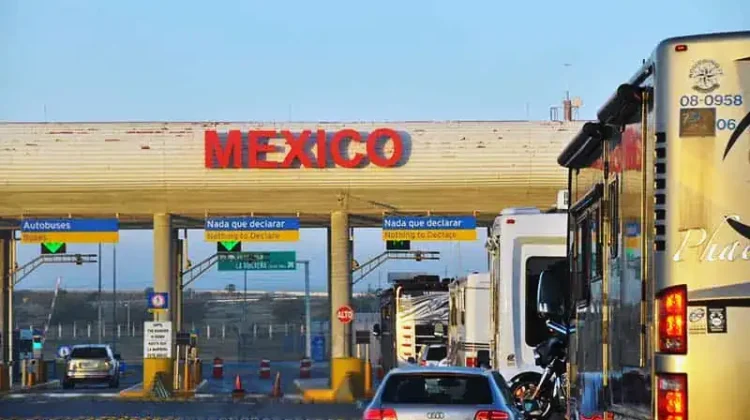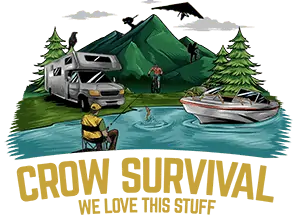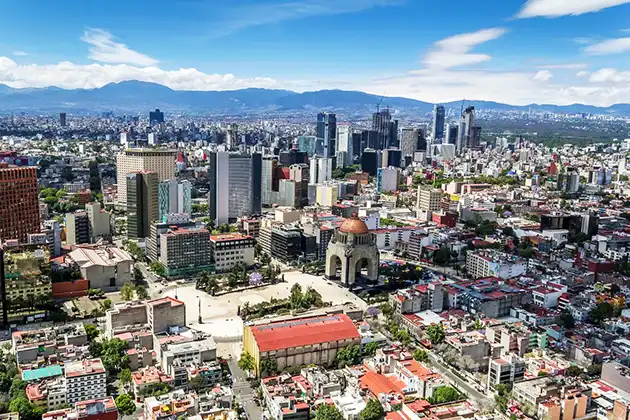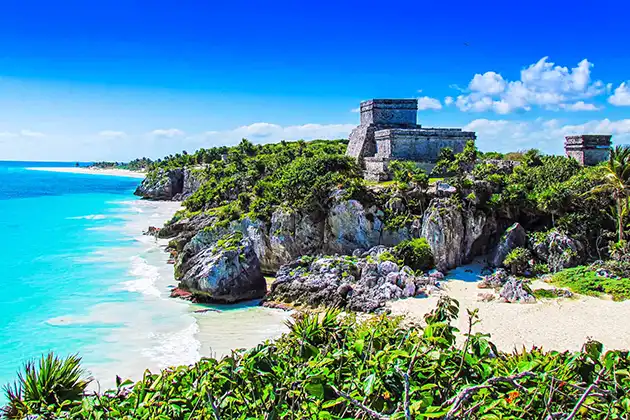
Thank you for reading our post, please rate this article at the end.
Reading Time: 10 minutesLast Updated on June 15, 2025 by Paul Clayton
Table of Contents
The Ultimate Guide to RVing in Mexico 33 Item Checklist
If you’re considering going to Mexico and want to RV across the border, you’re probably antsy, just as I was on my first RV trip.
Key Takeaways
-
-
Essential Documents Required:
-
FMM tourist card (must be stamped).
-
Mexican liability insurance (U.S. insurance usually doesn’t fully apply).
-
Vehicle registration matching your passport name.
-
Passport (bring a photocopy too).
-
Extra ID like driver’s license or birth certificate.
-
-
What NOT to Bring:
-
Illegal substances (even weed residue).
-
Firearms or any weapons.
-
Controversial literature or digital media.
-
Fresh meat and certain produce items.
-
-
Traveling with Pets:
-
No health certificate needed (since 2022), but rabies vaccine proof helps.
-
Limit of two pets per person; for more, pay a duty.
-
No reptiles or birds.
-
-
Border-Crossing Tips:
-
Have a clear story about your travel plans.
-
Avoid sunglasses, gum, or looking nervous.
-
Be polite and respectful to officers.
-
Keep your RV clean and windows down.
-
Always declare something at the border.
-
Confidence and eye contact go a long way.
-
-
Reasons You Might Be Pulled Aside:
-
Random checks.
-
Suspicious flags in your record.
-
RV description matching a watchlist.
-
-
Safety Tips While RVing in Mexico:
-
Stay within tourist zones and reputable areas.
-
Avoid flashy displays of wealth.
-
Bribery may happen — stay calm, never initiate.
-
Toll roads (cuotas) are safer and better maintained.
-
Never drive at night or boondock on unknown land.
-
Bring spare RV parts — they’re hard to find locally.
-
-
See, RVing across the Mexican border or any other border isn’t just something you do on a whim. It requires some planning, and from experience, it sucks most of the time. However, it’s worth it, and if you’re thinking of doing it, DO IT!
The good news is I regularly head south to Baja, Mexico, during winter, and I’m happy to share my experience. I’ll also detail everything you need to know about the border crossing and how you could make the process more seamless.
Required Documents to Drive Your RV Into Mexico
First, we’ll look at the essential documents you must bring when driving your RV across the Mexican border. Failure to obtain one of these documents may result in immediate denial of entry; they are crucial.
1) FMM
An FMM (Forma Migratoria Múltiple) is a multiple-entry tourist card or visa for Mexico. It’s the only way of registering your visit or temporary stay in Mexico. Failure to obtain an FMM means you’re in the country illegally and could be prosecuted for that.
Obtaining an FMM is especially important if you’re planning to drive your RV. After all, if you get in an accident and don’t have an FMM, your insurance will deny all liability and claims because you were in Mexico illegally.
There are two ways to apply for an FMM. The first is through the Instituto Nacional de Migración (immigration) offices at the border or online.
I recommend you obtain your Mexican tourist card at the offices on the day you cross the border. Online applications take time to process and may sometimes disappoint you, especially during high-traffic sessions.
Whatever method you choose, ensure that your FMM is also stamped; otherwise, it may be invalid.
2) Mexican Insurance
The other document you should be aware of, if you plan to drive to Mexico, is the Mexican liability insurance. Mexican border agents usually request it during inspections.
Fortunately, it’s easy to find a Mexican insurance provider at the border or the US border towns. Shop for insurance with better rates.
Can I use my US RV Insurance in Mexico?
Maybe, but highly unlikely. Most insurance companies do not provide full coverage to drive in Mexico with their existing U.S. policy.
However, some providers will cover your stay in Mexico, but with limitations. For example, some will work within 50 miles of the Mexican border, while others have add-ons for out-of-state coverage.
The only way to know if you’ll be covered is to review the insurance document yourself. If you’re still unsure, you can also ask your provider.
3) Vehicle Registration
Vehicle registration is necessary if you plan to bring your RV to Mexico. Furthermore, the registration details must match the details of your RV and passport.
If you borrowed the RV from a friend or family member, or if it was financed by the bank, you will need a notarized letter of permission to drive it.
4) Passport
You need a passport. No getting around it. So, if you’re planning to visit Mexico and don’t have a passport, apply now. Do the necessary paperwork and pay for it. At the border, you’ll be asked to produce your passport.
I advise you not to let them take possession of it. I’ve heard many horror stories of immigrant officers holding passports to coerce you into bribing them for non-existent traffic violations. So, instead, always have a photocopy of your passport, and when you get pulled over, hand over the photocopy.
5) ID
In addition to a passport, you must also carry other forms of identification, such as your national ID card. Your birth certificate and driving license may also help with proof of identity. Generally, the more identification you bring, the better.
What you shouldn’t bring
We’ve already reviewed the essential documents you need to bring for safe passage at the Mexican border. Now, we’ll look at the items that may land you in trouble if you’re found with them at the border crossing.
1) Illegal substances
This is a no-brainer. If you’re planning to cross the Mexican border in an RV, ensure you double-check your RV before leaving your house. This will put your mind at ease, knowing the border agents won’t find anything illegal.
It’s especially true for weed smokers. I’m not accusing anyone of being forgetful, but weed tends to break up easily and fall on stuff. Nuggets on your pants may re-surface during the inspection, and some asshole border cop may hear none of it.
In short, take everything out of the pack, and shake everything down if you don’t want to be blacklisted.
2) Weapons
Don’t have any weapons on you when crossing the Mexican border point. Guns and ammunition are a big no. You’ll go directly to Mexican jail without recourse if you’re found with any weapon.
I’d also suggest you leave your 5″ Switch knife among the cutlery and explain it’s cutting veggies and meats. But don’t risk bringing it if you don’t want to lose it.
3) Extreme Literature or Recordings
You mustn’t bring any socialist, communist, anarchist, or other “ist” paraphernalia that may piss the border agents.
I’ve had friends whose iPods have been confiscated, and the agents listened to the recordings for several hours. It shows you how far the agents are willing to go.
4) Fresh meat and produce
Several food items, such as fresh meat, are usually restricted at the border crossing. The list of specific foods can be overwhelming, but here’s a complete list of what is permitted and what isn’t.
Preparing to cross the border to Mexico is a great time to clean your fridge and freezer.
Crossing the Mexican Border with Pets
Generally, pets are welcome in Mexico, but some restrictions are still in place. Traditionally, a pet health certificate was required, but that was scrapped in 2022. However, you must show proof of rabies vaccine, but that’s not always requested at the border.
Only two pets are allowed per person. If you have more than that, you’ll need to pay import duty. You can’t bring reptile pets and birds to Mexico.
You can also bring up to 50 pounds of pet food per RV, but it shouldn’t contain beef products.
How to Pass the Mexican Border in a Breeze
Here are the top tips to help you with a seamless border-crossing experience.
-
Have a story
When crossing the Mexican border in your RV and the agents ask about your trip, always have a story and be intentional.
Just saying, “I wanna check out the place,” won’t cut it. You need to have something and be specific. For example, say, “I’m going to check out XXX and camp around XXX for a while.” This way, you sound like someone with a plan and not suspicious.
The process is even more straightforward if you’ve someone across the Mexican border who can vouch for you.
-
Don’t Use Sunglasses
Using sunglasses is the number one mistake you can make at the border crossing. Remember, agents are trained to watch people’s eyes and can detect liars by observing their eye movements.
So, if you’ve sunglasses on, you’ll be at the top of the agent’s list, and you might increase your chances of having your RV searched.
-
Don’t Chew Gum
Chewing gum while speaking to an agent can reveal your character. It’s also disrespectful to the officer talking to you.
While some people chew gum to calm their nerves, others may do so to subdue their drunken breath. Don’t take a risk.
-
Be Nice to the Officers and Show Some Respect
It doesn’t hurt to be friendly and respectful. Always address the agents as “Sir” or “Madam.” Remove your hat when speaking to them, and as I mentioned earlier, don’t chew gum.
Remember, the agents are doing their job; even if they’re giving you a hard time, they have a reason.
-
Make it clear you’re not intoxicated
Every time I cross the border, I come across completely drunk RVers. What do you think happens?
-
Always declare something
Always declare something, even if you’re slightly above the limit or have bought nothing. It’s better to stop at a border liquor store and buy something.
Border agents will be hard-pressed to believe you made it to the south and didn’t even bring a thing while you were there.
The trick is to be truthful, but don’t provide extra information or answer questions that weren’t asked.
-
Act and Be Confident
You can smuggle weed and probably not get caught, but don’t try it. The trick to that is remaining confident. Look at the agent in the eyes, and smile, but not excessively. And have your hands on the steering wheel.
-
Roll your Windows Down
You must roll down the windows when you’re next in line for inspection. It shows you’ve nothing to hide.
Border cops like to see what’s happening in the car and let them look inside and see everyone. Likewise, have all the passengers in your RV remove their hats and sunglasses.
-
Keep your RV Clean
A clean RV shows you’re responsible. Dressing nicely also makes you look better. Generally, the more “normal” you look when crossing the Mexican border, the less likely you are to raise suspicion or anything.
-
Don’t Fret
You might be pulled over, and it’s not a big deal. Remain calm, leave the windows down, and unlock your doors.
You should be fine as long as you have nothing to hide and no criminal records or DUIs. Be friendly, and understand they are simply doing their job.
-
Don’t Cross Illegally
I will never suggest or condone crossing to Mexico illegally. Buy, hey, trains and being dumb are a thing…
Why you Might Get Asked to Step Out of your RV
From experience, the three main reasons you might get asked to step out of your RV while crossing the Mexican border are:
-Randomness
Border agents will choose a few RVers after a given time for some random questions. Usually, the randomness may be due to profiling or a random algorithm. For example, you’ll likely be asked to stop if you pass the wrong hour.
–Suspicious File
Border agents have more information about you than you think. And so, the border agents will likely stop you for a search when they spot something suspicious in your file, such as a lost job, DUI charges, or something like that.
-Random description
You might be asked to step out if the agents have a random description corresponding to your RV.
Safety
If you plan to RV to Mexico, chances are you’ve already heard stories of how you’ll get mugged and everything. And I’m assuming it has already gotten into your head.
Now, the thing is that pretty much every country has some stereotypes. For example, we’re known for being exceptionally loud, racist, and bigoted. On the other hand, Mexico is known to have issues with drugs, crime, and corrupt law.
But the truth is, unless you encounter a Karen, you will likely be yelled at or profiled in the US. Same thing in Mexico… you’re less likely to run to drug lords or anything like that.
If anything, I’ve been to Mexico. From my conversation with locals, tourists are pretty safe because even cartels recognize how important they are to the economy, especially at the border. Furthermore, there’s always a heavy presence of security forces everywhere in town, seen and unseen. It’s not uncommon to see police walking casually with their M-4s.
However, you must never let your guard down, and you must consider these safety tips if you plan to visit Mexico:
Don’t Wander Out of Tourist Areas
Typical, dumbass American RVer is curious and will want to wander away from the designated tourist area. To make it worse, they start flashing money at everyone. This automatically sets a target on your back, and you’ll likely get mugged.
Bribery (Nah/ Yes)
There are mixed reactions to police ethics in Mexico, and the truth is that corruption is rampant.
Bribes are illegal in Mexico, but if you do it intelligently, you may save yourself from blowing a bunch of cash.
The agents usually stop you for minor traffic violations to scam you. In such cases, keep calm, don’t be rude, and handle the situation with social grace, and they’ll look at it as a failed attempt.
Stay in Better Neighborhoods
You must stay in the “better” neighborhoods and maintain a low profile, especially if you’re in the North of the country.
If you’re in doubt, you could sleep in a hotel. They’re relatively cheap and secure.
Don’t Do Dump Shit
When RVing in Mexico, try to be as law-abiding a citizen as possible. Don’t do sketchy stuff, don’t drink alcohol outside, don’t engage in crime, and keep away from sketchy people as much as possible.
Stick to the Toll Roads
Most roads in Mexico are not in the best state compared to the US interstate system. Most Mexican roads have “topes,” or rather large speed bumps that appear abruptly and may damage your RV.
However, if you stick to the toll roads, also known as “cuotas,” you’re less likely to experience these bad road conditions. Furthermore, Green Angels, the equivalent of AAA workers, are usually located on these roads, so you’ll likely get help if your RV breaks down.
Don’t Boondock
The US has plenty of readily available public parks where you can set camp, but not so for Mexico. You might find a free spot, only to realize it’s private land.
Now, some landowners may not be so forgiving or graceful, and it’s easy to become a target for anyone who’s up to no good.
So, start your RVing by sticking to the already-established RV parks.
Don’t Drive After Dark
There are several reasons you shouldn’t drive after dark in Mexico. For one, the Mexican road system doesn’t have excellent lighting compared to the US highways, which generally reduces visibility. The streets can be dark and dangerous to drive.
The other reason is the “topes” or gaping holes that often appear out of nowhere. These can also do tremendous damage to your RV.
Bring Extra RV Parts
Finally, understand RVing isn’t as popular in Mexico as it is in the US. There is limited infrastructure for RV parts and other essential supplies. Getting simple replacement RV parts is a Herculean task.
To avoid all these hassles, it’s a good idea to always bring your RV’s spare parts.
Final Thoughts
Mexico is a beautiful country with amazing people. RVing to Mexico is genuinely worth it, and it could probably be one of your life experiences.
The trick to a successful trip to Mexico is to adhere to all legal requirements and be polite to border agents and locals.
It would also help if you learned some Spanish beforehand; you’ll have a fun and great time.
Home page
Back to the top of the page











